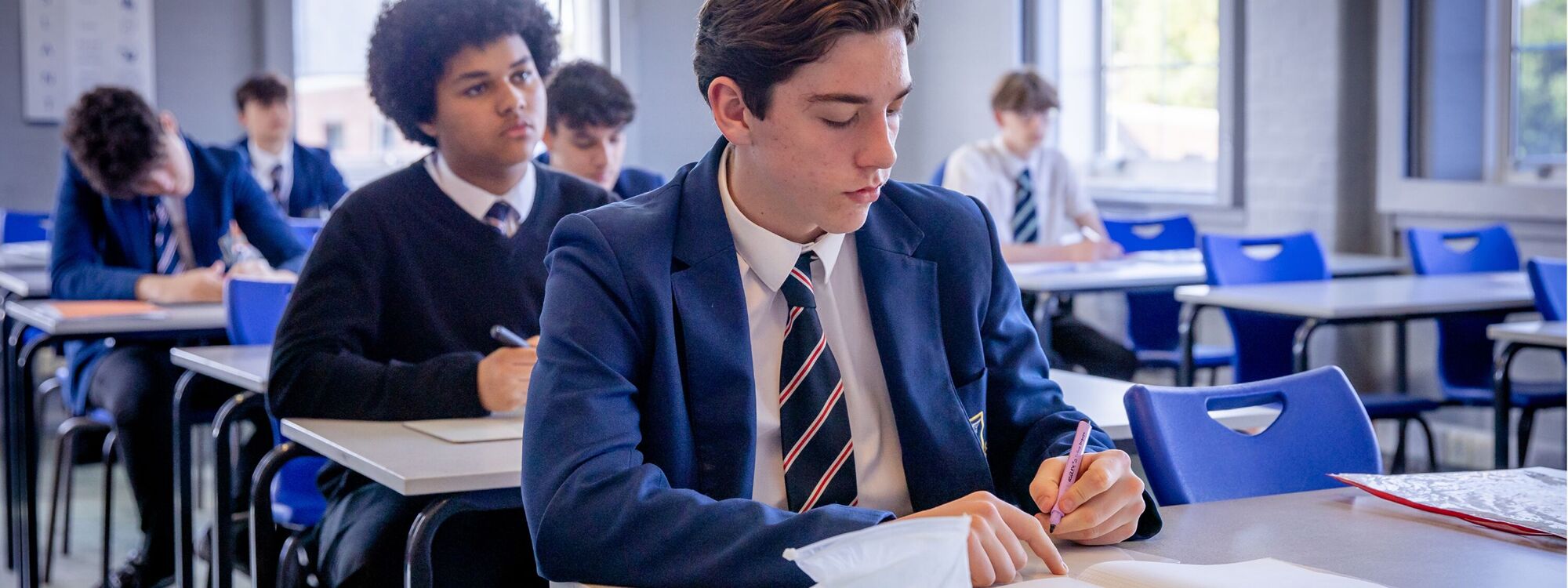Assessment Overview
At Glyn, we have high expectations of what our students can achieve. Our highly ambitious curriculum is underpinned by assessment and feedback strategies that aim to support our students’ progress, to check understanding, to deepen learning and to identify and address misunderstandings. This process is intended to close the gap between where the students are and where their teachers want them to be.
Responsive Assessment
Students in all year groups (from Year 7 to 13) are frequently assessed. This frequent, responsive assessment takes place in lessons and enables teachers to check the understanding, learning and progress of all students on a lesson by lesson basis. It is a quick and efficient means of assessing in the moment.
By establishing a positive climate in lessons, teachers are able to assess in a way that is academically challenging but non-threatening. This approach encourages students to take risks and become resilient learners.
Students often use mini-whiteboards in lessons; these enable teachers to see the response of each student. They are able to give immediate feedback on the students’ responses and adapt their teaching accordingly.
Responsive assessment enables teachers to identify how best to address misunderstandings and to see when students have acquired knowledge and/or mastered a skill. It gives them a good idea about when students are ready to move on.
Formative Assessment
The type of formative assessment used varies depending on the subject and skills being assessed. For example, teachers use varied questioning techniques aimed at all students, they set mini-tests and multiple choice quizzes, they make use of online learning platforms, they watch students performing certain skills. Like responsive assessment, it is used to uncover hidden knowledge gaps and to strengthen students’ long-term memory.
Summative Assessments
Progress Checks
Students in all year groups (Year 7 to 13) complete progress checks. These progress checks assess recently taught content and content that could have been taught up to several years earlier.
Teachers make reasonable adjustments during progress checks for those students who have been identified by the SEND team and/or the Head of Year.
Assessing recently taught content enables teachers to assess students’ understanding. Assessing content taught sometime ago gives teachers some idea about the depth of students’ learning and their performance at a given time.
Students are taught how to revise by their subject teachers. Revision strategies may differ, depending on the subject.
The progress checks are marked by teachers and students are ranked into percentile ranges which are compared over time to make inferences about student progress in the curriculum.
The progress checks enable teachers to identify any gaps in students’ understanding and learning.
At the end of Year 10, the students are given a raw mark and percentage for their progress check. The progress results help teachers to tailor their teaching and to decide on the interventions needed for Year 11.
Teachers give students feedback on their progress checks. Written marking and feedback is driven by teacher professional judgement and may differ by subject.
Progress Tests (Year 7 and 8)
GL Assessment Progress Tests are conducted in English and Maths in September of Year 7 and 8 (details of the test can be found here). These tests are standardised on over 100,000 students, with benchmarks verified each year based on analysis of over half a million students. These tests provide us with data to help identify students who may need additional support and allow us to identify patterns of performance. In addition, these tests allow for a comparison of our students against a national data set.
PPEs (Pre-Public Examinations)
The purpose of summative assessments is to assess the student’s learning over a longer period of time.
At the end of Year 12 and during Year 11 and 13, students sit PPEs. The PPEs provide students with the opportunity to do assessments that reflect some, or all, elements of the GCSE and A Level examinations.
At the end of Year 12, the PPEs are graded and help to inform teachers’ predicted grades for UCAS. The PPE results help teachers to tailor their teaching and to decide on the interventions needed for Year 13.
In Year 11 and 13, the PPEs are held twice a year and they are graded. The marking of PPEs is standardised and moderated. The grades are calculated using the exam board grade boundaries from the year before. These grades enable teachers to make GCSE or A level predictions. These PPEs go some way to replicating the conditions that students will experience during the actual GCSEs and A Levels.
Eligible students have examination access arrangements in place for their PPEs.



